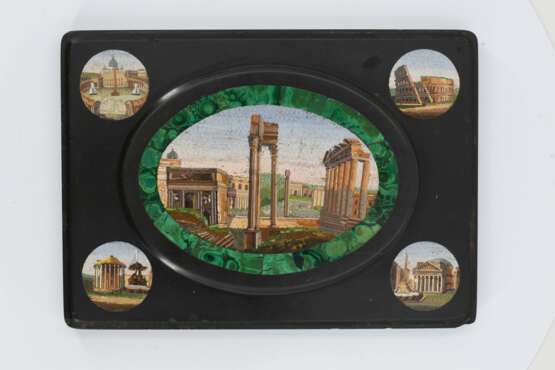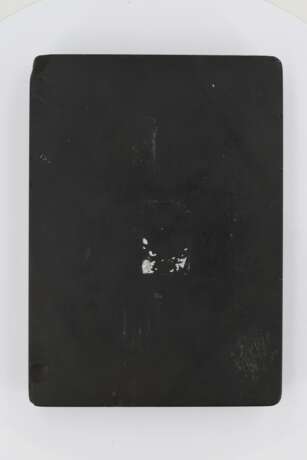ID 895546
Lot 1495 | Micromosaic with Roman cityscapes
Estimate value
€ 1 000 – 1 500
Rom.
Date: 19th century.
Technique: Micromosaic made of black marble and malachite.
Description: Rectangular panel with an applied oval medallion, depicting a view of the Forum Romanum.
In the corners of the panel four small mosaics with St. Peter's Square, the Circus Maximus
as well as the Temple of Hercules Victor and the Pantheon.
Measurement: 17,5x12,5x2,5cm.
Literature:
Domenico Petochi: I Mosaici Minuti Romani, Rome 1981. Comparable panels see p.134 & S.137.
THE ART OF THE MICROMOSAIC
The term "micromosaic" was coined by Sir Arthur Gilbert, a businessman and art lover who over many years built up one of the most important collections of micromosaics. The so-called "Rosalind and Arthur Gilbert Collection" is now kept in the Victoria and Albert Museum in London. The art of micromosaic has existed for centuries. The production of the two pieces offered here dates back to the end of the 18th century and the beginning of the 19th century, when the technique of micromosaic was revived in the Vatican workshops for a very mundane reason. The order situation for large mosaics was rather modest at the end of the 18th century. So the idea came up to produce the large paintings of St. Peter's Basilica as small micromosaics and to sell them as souvenirs to the Italian tourists of the so-called Grand Tour. The Vatican workshops had a not inconsiderable additional source of income from the sale, so that there were soon other workshops of this kind. Around 1810, around 20 private workshops existed around the Spanish Steps. The little stones of glass flow not only formed small pictures as paperweights, they also adorned tabatiers, pieces of jewellery or even table tops. Most of the pieces remained unsigned and undated.
The micromosaic from this auction, with the sights of Rome from the 19th century, is a fine example of the Grand Tour souvenirs mentioned above. On display here are the popular Italian vedute - centrally, of course, the Roman Forum, and in the four small circular mosaics, St Peter's Square, the Circus Maximus, the Temple of Hercules Victor and the Pantheon.
Literature:
Hanisee Gabriel, Jeanette: The Gilbert Collection Micromosaics, London 2000.
| Auction house category: | Early Works of Art |
|---|
| Auction house category: | Early Works of Art |
|---|
| Address of auction |
VAN HAM Kunstauktionen GmbH Hitzelerstr. 2 50968 Köln Germany | ||||||||||||||
|---|---|---|---|---|---|---|---|---|---|---|---|---|---|---|---|
| Preview |
| ||||||||||||||
| Phone | +49 221 92586215 | ||||||||||||||
| Fax | +49 221 92 58 62 4 | ||||||||||||||
| Buyer Premium | 32% | ||||||||||||||
| Conditions of purchase | Conditions of purchase | ||||||||||||||
| Business hours | Business hours
|






